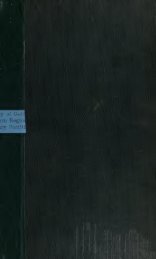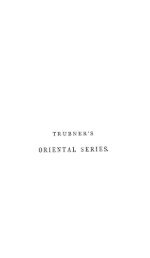Untitled
Untitled
Untitled
Create successful ePaper yourself
Turn your PDF publications into a flip-book with our unique Google optimized e-Paper software.
'<br />
'<br />
NOTE XI. THE HOUSE OF BURHAN ,<br />
><br />
.in<br />
(6) Burhanu'd-Din Mahmiid ibn Taju'l-Islam Ahmad, a*uthor of<br />
the Dhakhiratu'l-Fattiwd (also called adh-Dhakhiratu'l^Bnrhdfiiyyd)<br />
mentioned by Hajji Khalifa.<br />
(7-10) Burhanu'd-Din Muhammad Sadf-i-Jahan ibn Ahmad, brother<br />
of the above; his two sons Maliku'l-Islam and 'Azizu'l-Islam, and another<br />
brother, Iftikhar-i-Jahan. The rst of these four was practically King<br />
of Bukhara and paid tribute to the Khita'is) as indicated by a passage<br />
in an-Nasawi's Biography of Sultan Jalalu'd-Dfn Mankobirni 1 . Ijl<br />
603/1206-7, while on his way to Mecca, he was received with great<br />
respect at Baghdad, but on his return there, account of his behaviour<br />
or^<br />
towards the pilgrims, he incurred such unpopularity that he earned for<br />
himself the nick-name of Sadr-i-Jahannam (the "Chief" or "President of<br />
Hell"). In 6131-614/1316-17, when 'Ala'u'd-Dm Muhammad Khwarazmshah<br />
set out on his campaign against the Caliph an-Nasir li-Dini'llah, as<br />
a precautionary measure he deported these four persons (Burhanu'd-Din<br />
Muhammad and his brother and two sons) from Bukhara to Khwarazm.<br />
Two years later (in 616/1219), when Khwarazmshah's mother Turkan<br />
IQiatiin decided to flee thence for fear of the Mongol advance, she put<br />
aS four of them to death, together with other hostages resident at her<br />
capital 2 .<br />
(n) Sadr-i-Jahan Sayfu'd-Din Muhammad ibn 'Abdu'l-'Aziz (son of<br />
No. 5), who is repeatedly mentioned as still living in 'Awfi's Lubdbu'l-<br />
Albdb, which was written in 618/1221.<br />
(12) Burhanu'l-Islam Taju'd-Din 'Umar ibn Mas'iid ibn Ahmad ibn<br />
'Abdu'l-'Aziz ibn Maza (grandson of No. 3, nephew of Nos. 6, 7 and 8,<br />
and cousin of Nos. 9 and 10). He was one of the teachers and masters<br />
of 'Awfi, who makes mention of him also in the Lubdb (ed. Browne,<br />
vol. i, pp. 169174).<br />
(13) Nizamu'd-Din Muhammad, son of the above, also mentioned<br />
by 'Awfi (i, 176), who spent some days with him at the town of AmA 3<br />
ori the Oxus about 600/1203-4.<br />
(14) Another Burhanu'd-Din (pedigree unspecified) is mentioned by<br />
'Ala'u'd-Di'n 'Ata Malik-i-Juwayni in connection with the rebellion of<br />
Tarabi in 636/1238-0^. ,<br />
The latest historical reference to any member of this family occurs<br />
in the To!rikh-i-Jahdn-drd of the Qadi Ahmad-i-Ghaffari, who states<br />
that Uljaytd (Khuda-banda, reigned A.D. 1303-1316) was impelled to<br />
embrace the Shi'a doctrine by his disgust at the unseemly altercations of<br />
'two Sunni theologians of different schools, Khwaja 'Abdu'l-Malik the<br />
Shafi'i, and Sadr-i-Jahan J of Bukhara the Hanafi. The title, place of<br />
1 This ''passage is cited in the Persian notes, p. 118, fourth line from the end to<br />
>p. 119, 1. 6. It occurs on pp. 23-4 of the edition of M. O. Houdas (Paris, 1891), and<br />
on pp. 41-2 of his French translation (Paris, 1895).<br />
2 Ax-Nasawi (ed. Houdas), p. 39 = pp. 66-7 of the French translation.<br />
3 See Yaqut's Mu'jamu'l-Bulddn, vol. i, pp. 69-70, and G. le Strange's LandS of<br />
the Eastern Caliphate, p. 434. The town is also called Amul by the Arabs, like the<br />
better-known town of that name in Mazandaran.<br />
4 See Mirza Muhammad's edition of the Tdrikh-i-Jahdn-gushdy, vol. .i, p. 88<br />
(" E. J. W. Gibb Memorial " Series, xvi, i).<br />
t<br />
I








![La religione di Zarathustra nella storia religiosa dell' Iran [microform]..](https://img.yumpu.com/15970820/1/151x260/la-religione-di-zarathustra-nella-storia-religiosa-dell-iran-microform.jpg?quality=85)


